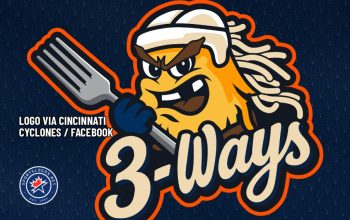
The Ontario Hockey League’s Guelph Storm raised a different kind of cup this past weekend while acknowledging a major part of sports history both in their city and across the whole world.
The Storm unveiled their Royal City Jockstraps alternate identity last week, which they used for games on Friday, January 31, against the Sarnia Sting and Sunday, February 2, against the Ottawa 67s. The identity pays homage to a team of the same name that played in Guelph in the 1920s — and one of its players who improved on the invention that has helped athletes across the sports world.
The logo for the Jockstraps was designed by the Storm’s in-house graphic designers, Darius Navarro and Hunter Sutherland. “The design boasts a humourful logo of a superhero-style peanut suited up with a jock shield that is battle-ready, an orange cape, and of course, a hockey stick,” the team says on its website. “The design also features an additional logo on the shoulder of two peanuts with the jock shield and a crown on top as a nod to the Royal City name.”

According to the Storm, the original Royal City Jockstraps started as the Guelph Elastic Stretchers in 1926, named after the Guelph Elastic Hosiery Co. factory that opened in the city some 20 years earlier. The team “had a history of spirited, though often reckless, games. They were known for charging the ice with all the finesse of a bull in a china shop. Slapshots were hard and wild, but rarely on target. Checks were delivered with enthusiasm, but accuracy wasn’t a priority. And when it came to skating, they moved like a herd of bison, each player in pursuit of the puck, regardless of whether it was in their possession or not.”
One night, goaltender Jimmy “Buster” McGrath took a puck to the groin and was down on the ice for some time. When team captain Tommy “Frosty” Johnson went to check on him, he got the idea to put a pocket in a traditional jockstrap, into which he inserted a protective cup. “The next practice, Tommy proudly presented the creation to his team. ‘Gentlemen, behold the future of hockey safety,’ he said, raising the cup high. Buster, still nursing his sore spots, was the first to try it on. He strapped it on, and despite a few odd looks from the rest of the team, he felt something incredible: relief.”
In the 1927 championship game between the Stretchers and the Waterloo Wranglers, it’s said that, with the score tied in the final seconds, a Wranglers slapshot ricocheted off Buster’s reinforced jockstrap straight to Frosty, who went down the ice and scored the game-winning goal. The following season, the team immortalized Tommy’s ingenuity by changing its name to the Royal City Jockstraps. The “Royal City” moniker coming from the fact that Guelph was named after the British Royal Family.

The Jockstraps jerseys worn over the weekend were predominantly orange, with a broad cream stripe and a thin black stripe running all the way around the chest and back, with the peanut logo sitting on top of the stripes on the front. The broad cream stripe and narrow black stripe also run around each elbow. Cream and black stripes of equal width run around the waist and cuffs.



Names and numbers on the sleeves and back were one-colour black, with the numbers set in a block font. The socks were orange with the same striping pattern as the jersey sleeves. They were paired with black helmets, black gloves and black pants with stripes down the sides from the Storm’s regular uniform set.


Royal City Jockstraps merchandise — including T-shirts, hats, hoodies and novelty items — were available for sale at the arena and online. The rebrand even included a new mascot for the Jockstraps, fittingly named “Nutty.”


The Storm will wear their Royal City Jockstraps for one game per season going forward, with jerseys being auctioned off to benefit local charities. This year’s jersey auction will benefit Victim Services Wellington, which provides provides support, referrals, safety planning, advocacy and education services to victims of crime.











